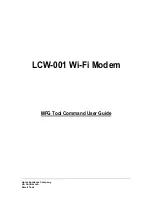
DART 200 CDPD Modem User’s Guide
8 Application Programming
Sierra Wireless, Inc.
8-14
Hardware flow control operation
The
DART 200 communicates with the MAS using the CTS lead
(modem controlled) when receiving data, and sensing the RTS lead
(MAS controlled) when sending data.
When the modem receives data from the MAS it holds the CTS line in
the ON state and only transitions it to the OFF condition to exert flow
control (stop data transmission from the MAS).
When the modem sends data to the MAS it monitors the RTS lead from
the MAS; sending data only when RTS is ON, and stopping when the
MAS exerts flow control (wants to stop data transmission from the
modem) by transitioning RTS to the OFF condition. If Hardware Flow
Control is specified, the modem does not begin data transfer to the MAS
unless RTS is ON.
PAD operating mode
The DART 200 is capable of operating in two modes while transferring
data:
•
Packet Assembler - Disassembler (PAD) mode - When in PAD mode
the internet protocol support is provided by the modem
•
SLIP mode - When in SLIP mode the internet protocols are provided
by a software stack in the attached device, usually a PC
The DART uses PAD mode to provide support for UDP, TCP, and
telnet. The form of the dial command (
ATDT
or
ATDP
) specifies to the
modem whether TCP or UDP protocol should be used. However, telnet
is a TCP application; something more than the form of the dial command
is required to inform the modem that it should operate in telnet rather
than straight TCP mode. This function is provided by the
\O
parameter.
Telnet mode is specified by the
\O1
parameter (default setting). When a
telnet session is established the modem will begin a negotiating process
with the host to determine the terminal being emulated, whether local or
remote echo will be used, as well as other operating rules for the session.
In addition, when data transfer starts only printable characters and
control characters will be passed. This mode of operation is not suitable
for any application other than telnet: it is not compatible with telemetry
requirements.
For telemetry the option should be changed to
\O0
and saved with the
&W
command. However, this causes some potential problems because
the
\O
parameter also controls the
F, \M
, and
\T
settings. Each
\O
setting
has a preferred setting for
F, \M,
and
\T,
which may not be compatible
with the end-user's program. The couplings are shown in Table 8-1.
CAUTION:
Whenever \O is
changed, verify that the
F, \M, and \T settings
are still appropriate for
the application.
Summary of Contents for DART 200
Page 4: ...DART 200 CDPD Modem User s Guide Sierra Wireless Inc iv...
Page 18: ...DART 200 CDPD Modem User s Guide About This Guide Sierra Wireless Inc xviii...
Page 50: ...DART 200 CDPD Modem User s Guide 3 CPDP Security Features Sierra Wireless Inc 3 4...
Page 86: ...DART 200 CDPD Modem User s Guide 5 DART Supported Protocols Sierra Wireless Inc 5 32...
Page 90: ...DART 200 CDPD Modem User s Guide 6 Device Attachment Sierra Wireless Inc 6 4...
Page 94: ...DART 200 CDPD Modem User s Guide 7 Vehicle Installation Considerations Sierra Wireless Inc 7 4...
Page 120: ...DART 200 CDPD Modem User s Guide 8 Application Programming Sierra Wireless Inc 8 26...
Page 130: ...DART 200 CDPD Modem User s Guide D SLIP Setup Examples Sierra Wireless Inc D 4...
Page 144: ...DART 200 CDPD Modem User s Guide E S Registers Sierra Wireless Inc E 14...
Page 169: ...DART 200 CDPD Modem User s Guide F DART AT Command Set PN1197 00 Revision 1 0 F 25...
Page 176: ......
Page 180: ...DART 200 CDPD Modem User s Guide H Problem Sheet Sierra Wireless Inc H 2...
Page 202: ...DART 200 CDPD Modem User s Guide Index Sierra Wireless Inc Index 10...
















































